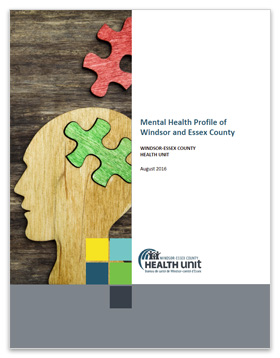The Mental Health Profile of Windsor and Essex County was prepared by the Windsor-Essex County Health Unit with the objective of capturing the current status of mental health in our community. This report describes local statistics, emerging trends, and at-risk populations in regards to mental health, work stress, and intentional self-harm using various indicators and data sources. The key findings of this mental health status report are summarized below.
Key Findings
- Poorer mental health and well-being among the Windsor-Essex County population was associated with older adults (45-64 years old), low household income, and lower educational attainment. The mental health and well-being of the Windsor-Essex County population was similar to Ontario based on the indicator estimates.
- Nearly 72% of Windsor-Essex County residents reported very good or excellent mental health and 81% reported feeling happy every day or almost every day in the past month.
- Over 1 in 10 workers in Windsor-Essex County experience unhealthy workplace conditions that contribute to disproportionate work stress that exceeds work satisfaction. Work stress is particularly prevalent among older adults (45-64 years old) as over 30% reported that most days at work are quite a bit or extremely stressful.
- The rate of emergency department (ED) visits for intentional self-harm increased by 28% in Windsor-Essex County between 2011 and 2015 (in fact, the 2015 rate was at a 9-year high for the region). This increase is primarily driven by increased ED visits among youth for self-harm injuries; from 2010 to 2015 the local rate of ED visits for self-harm among youth increased by 143% (that is, the rate was 2.4-times greater in 2015 compared to 2010).
- Nearly 80% of self-harm ED visits were caused by intentional self-poisoning and in almost all cases the poison was some form of medication.
- The rate and number of self-harm mortalities showed an increasing local trend between 2003 and 2011 (most current year that mortality data is available). Males accounted for nearly 3 in 4 intentional self-harm deaths and the mortality rate was greatest among residents aged 45-64 years old.
- Most patients treated for self-harm injuries were from the downtown core of Windsor and this area also had one of the highest mortality rates for self-harm injuries.
- The rates of ED visits for self-harm were significantly lower in Windsor-Essex County compared to the provincial rates; however, the self-harm mortality rates did not differ between Windsor-Essex County and Ontario.
The findings of this report – in combination with the Ontario Public Health Standards – were used to develop recommendations to guide local public health strategies and initiatives involving mental health and intentional self-harm.
Recommendations
- The considerable increase in the rate of emergency department visits for intentional self-harm injuries among youth (10-19 years old) requires immediate priority action and warrants on-going assessment and surveillance.
- Self-harm reduction strategies should target residents from the City of Windsor who live in low income households and have lower educational attainment. Youth (10-19 years old) and older adults (45-64 years old) from these populations are at a higher risk.
- Enhance mental health literacy and awareness in the community, particularly among target populations. Residents should have access to mental health resources, including educational material, crisis help-lines, and other mental health supports.
- Support policies and initiatives that reduce and restrict access to the methods of intentional self-harm; restricting unnecessary access to medications, particularly among youth, should be a priority.
- Form active collaborations and partnerships with external organizations involved with self-harm reduction and mental health. Engagement with schools and workplaces regarding mental health and well-being initiatives would be an asset.
Self-harm reduction strategies should implement activities that are clearly supported by scientific evidence. These activities should be evaluated regularly to determine their impact and to find opportunities for improvement.
The findings and recommendations of this report can be used to inform decision-making processes, support planning, and provide direction for new or existing programs and initiatives in our community. Promoting positive mental health and preventing intentional self-harm injuries in our community will require a collaborative and comprehensive strategy that involves partners and leaders from across all sectors. The Windsor-Essex County Health Unit is willing to collaborate with community partners to move this work forward.


